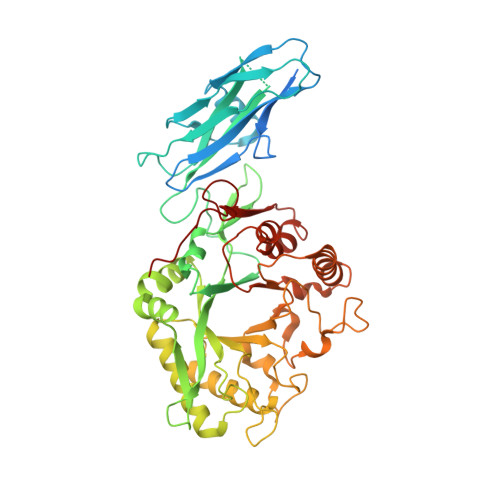Human gut microbes express functionally distinct endoglycosidases to metabolize the same N-glycan substrate.
Sastre, D.E., Sultana, N., V A S Navarro, M., Huliciak, M., Du, J., Cifuente, J.O., Flowers, M., Liu, X., Lollar, P., Trastoy, B., Guerin, M.E., Sundberg, E.J.(2024) Nat Commun 15: 5123-5123
- PubMed: 38879612
- DOI: https://doi.org/10.1038/s41467-024-48802-3
- Primary Citation of Related Structures:
8U46, 8U47, 8U48, 8U9F, 8W01, 8W04 - PubMed Abstract:
Bacteroidales (syn. Bacteroidetes) are prominent members of the human gastrointestinal ecosystem mainly due to their efficient glycan-degrading machinery, organized into gene clusters known as polysaccharide utilization loci (PULs). A single PUL was reported for catabolism of high-mannose (HM) N-glycan glyco-polypeptides in the gut symbiont Bacteroides thetaiotaomicron, encoding a surface endo-β-N-acetylglucosaminidase (ENGase), BT3987. Here, we discover an ENGase from the GH18 family in B. thetaiotaomicron, BT1285, encoded in a distinct PUL with its own repertoire of proteins for catabolism of the same HM N-glycan substrate as that of BT3987. We employ X-ray crystallography, electron microscopy, mass spectrometry-based activity measurements, alanine scanning mutagenesis and a broad range of biophysical methods to comprehensively define the molecular mechanism by which BT1285 recognizes and hydrolyzes HM N-glycans, revealing that the stabilities and activities of BT1285 and BT3987 were optimal in markedly different conditions. BT1285 exhibits significantly higher affinity and faster hydrolysis of poorly accessible HM N-glycans than does BT3987. We also find that two HM-processing endoglycosidases from the human gut-resident Alistipes finegoldii display condition-specific functional properties. Altogether, our data suggest that human gut microbes employ evolutionary strategies to express distinct ENGases in order to optimally metabolize the same N-glycan substrate in the gastroinstestinal tract.
Organizational Affiliation:
Department of Biochemistry, Emory University School of Medicine, Atlanta, GA, USA. dsastre@emory.edu.














